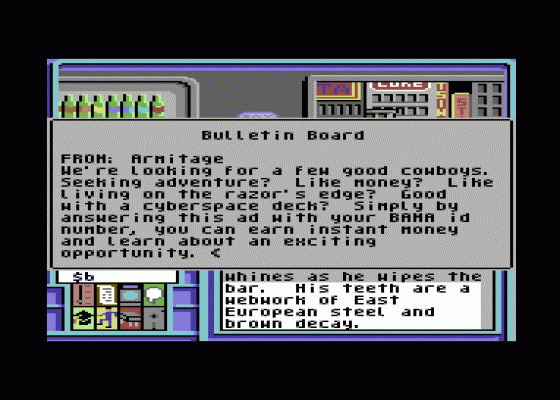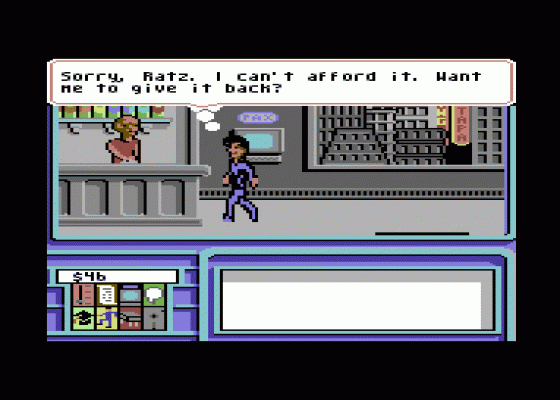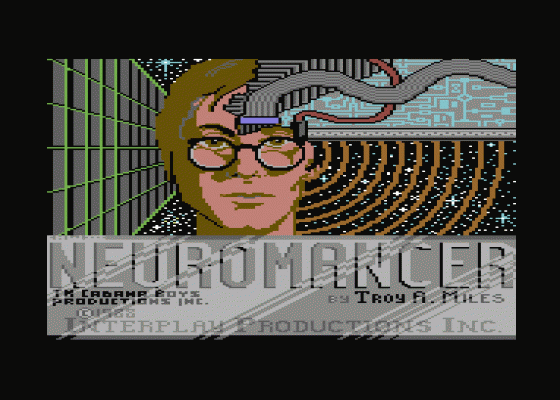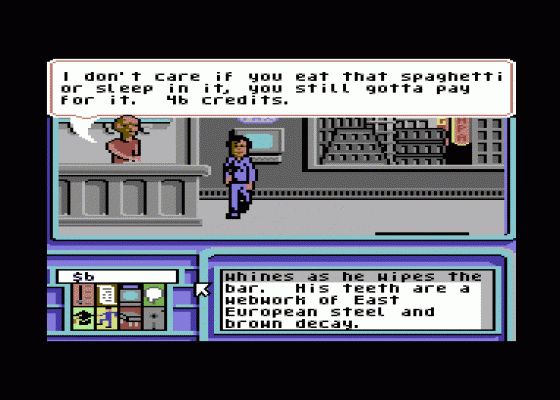
C&VG
 1st January 1989
1st January 1989
Categories: Review: Software
Author: Ciaran Brennan
Publisher: Electronic Arts
Machine: Commodore 64/128
Published in Computer & Video Games #87
Neuromancer
Neuromancer is the second release from the new independent software house, Interplay, following on from Battle Chess.
The normal way to open a review is to tell you which pigeonhole the game falls into. Neuromancer doesn't fall into any, much in the same way that Times Of Lore doesn't.
In Neuromancer, which incidentally, is a cyberpunk adventure, you are a novice cyberspace cowboy, with nothing but a VXB deck and a copy of Comlink 1.0. Before I start confusing you all with credit chips, chip implants, Rom constructs and weird computerised journeys through the mind, I'd better explain how it all works.

You are given the task of discovering what is happening to all the Cyberspace Cowboys that are all being killed or just vanishing. This is done quite easily with just a bit of detective work. A small part of the work involves physically travelling around the streets and talking to people, talking your way into and out of restricted areas, occasionally getting arrested and trundling into areas where you're not supposed to go. This is only a very small part of it.
A lot of the work boils down to talking to people that you never meet, over modem links. The whole game revolves having expensive, more capable machinery (decks, as they're known) and having advanced software. The most important things to get are these: a cyberspace compatible deck and Comlink 6.0 or later.
First thing is the deck - how do you get one? Well, to start with you have six dollars on your credit chip (a form of credit card, except that you actually except that you actually carry the currency on it.) You can download money onto your chip by using the PAX terminals dotted around (more later) as you begin with $2,000 in the bank. There are two important things to remember here. One: you can always get arrested for the most unlikely thing, like cheeking a cop, so always leave money in the bank so that the regular $500 can be removed in the form of a fine. Two: before you start, you have to pay the barman at the bar where you've been sleeping in the disk of the day, synthi-spaghetti. Three cyberspace compatible decks cost in the region of $20,000 upwards - you don't have access to that kind of money to start with, so you have to (a) get a translation of as many things for free as possible and (b) get as much money as possible. You can get money by selling bits of your body, but you only get cheap plastic replacements that wear out quickly. Is it worth it?

The other thing I mentioned was the Comlink 6.0. Comlink is an item of softwarez (yes, that it how you spell it!) and you can't run your deck without softwarez. You begin with a very low standard deck and Comlink 1.0. Version 1.0 can only connect to the most simple and basic of systems, so an upgrade is definitely worth sniffing out. Version 6.0 is ideally what you want, because then you can go into cyberspace.
Cyberspace is a non-existent world projected from your deck into your mind. What it is is three-dimensional information, and it's in this state that you transcend from basic modem hacking into a real and frightening world. All the various computer systems, from now on known as bases, are represented as mathematical shapes, and it's these you have to try and get into. Some are protected, and some are heavily protected. By what?
By ICE intruder countermeasure electronics. What do you use to get past the ICE? The same thing the whales did. You use an ICE-breaker. An Icebreaker is another type of softwarez, and there are lots of different types.

Now the technical aspects. The PAX system is a system not unlike teletext. It provides free access to a banking system, a daily newspaper and a bulletin board, with which you can pick up some pretty hot hints and job offers. As well as the odd snatch of humour. One thing that made me chuckle was an advert from Interplay for Bard's Tale 714 and Wasteland 4. You can leave messages as well, and there's quite a snazzy little earner than makes you $10,000 without doing anything if you go the right way about it, but I'm not telling you where.
The modem system consists of finding a jacking-in plug and connecting the appropriate software. Then you have to enter a connection code to link up to a base. If you have a high enough level of software, you link up and have to enter a password. The right passwords can get you through to higher levels of access, giving you a greater amount of things to do. For example, on level one access at the Cheapo Hotel, you can review or pay your bill. On level two, you can review, pay or alter your bill. Handy if you haven't got any money and need some caviar. All this jacking on costs money, in much the same way as a modem, so you have to keep an eye on your money. The really high access calls to the really distant companies don't half make your money drop.
There are other subtleties to the game, as well. Things like skill chips, which can be directly implanted onto your brain and give you skills you never thought you could get, like cryptology and hardware repair - even Coptalk, which gives you the skill of being able to talk like a cop.

In between all this jacking on and talking to others, you have a lot of walking about to do. This is all viewed side-on, with your man roaming around in a full 3D environment. At the bottom of the screen is a block of eight icons. These control things like your inventory, the manipulation of items and the disk access. It also contains the conversation icon, which, when clicked on, gives you a list of possible and suitable phrases you can say to present company either to start or continue a conversation. One of my favourites is "Finn. Did you know that your head looks like it was designed in a wind-tunnel?"
The graphics are pretty good, and the animation of the main character as he walks from left to right and vice versa is great - just see the way he struts.
Sound is great; lots of little spot effects and a fairly decent tune take all the auditory section of the main game, but the loading music is fab. All digitised, it features a track by none other than Devo.
I'm not going to say that Neuromancer is the best game I've ever played - it's just very, very good. It takes a little while to fully understand exactly what is going on and what exactly you're doing, but it's worth it in the end. Another goodie from Interplay.
Other Reviews Of Neuromancer For The Commodore 64/128
Neuromancer (Interplay/Electronic Arts)
A review
Neuromancer (Electronic Arts)
A review by Ken McMahon (Commodore User)
Other Commodore 64/128 Game Reviews By Ciaran Brennan
Scores
Commodore 64/128 Version| Graphics | 73% |
| Sound | 87% |
| Playability | 96% |
| Lastability | 93% |
| Overall | 90% |






